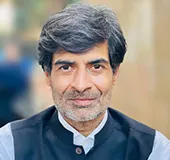At the cusp of the 2020s, what are the markers of change in the international system? The challenges are tectonic and technological and causing four major disruptions. First, the neat correlation of a big economy with big power that bears big responsibilities is under scrutiny. After World War II, the globe’s largest economies were also its ultimate security guarantors, institution incubators and norm shapers. Today, the economic and domestic political capital of a great power with a per capita income of US$40,000 is just not replicable by an emerging power with a per capita income of US$10,000.
The latter faces inequities and developmental gaps at home, and its generosity will perforce be constricted. Populist politics will anyway make it harder for any power – old or emerging – to be an unremitting provider of global public goods. To add to that, the largest economies of this century will also be among the weakest societies – a new paradigm.
Second, there is a creeping capture of provision of public goods and services by business corporations and large transnational philanthropic entities. For example, the developing world’s public health agenda is being influenced by a Bill and Melinda Gates Foundation, in some cases to a greater degree than by the World Health Organisation.
The Trump administration’s resolve to cut US funding for development programmes that support abortion services is being supplanted by large American charities and philanthropic institutions that see the right to choose as central to women’s health and empowerment. Such processes will curb the autonomy – or excesses – of national governments seeking to achieve politically desirable goals.
In the economic sphere too the concept of public goods and private provision – and of where the state, as the traditional provider of public goods, comes into this dynamic – has to be considered afresh. In most societies Internet and data services comprise a public utility being delivered by private corporations. Tesla and Uber (and Ola in India) are current and future providers of public transport networks without which cities will be unable to do business. Yet they are also networks over which the government – or even traditional pressure groups such as trade unions – have only nominal control.
The devolution of a “public goods provider” role has in turn generated thinking on quasi-government obligations among futuristic corporations. That is why suggestions of an income tax to be paid by robots have come from the founder of Microsoft; or why the chief executive of Tesla – its driverless cars will disrupt driver communities – has urged governments to institute a universal basic income.
Third, there is an uneasy but imminent transition in industrial production from human-intensive to machine-driven ecosystems. The early 21st century will see the maturing and possible commodification of a menu of new technologies – artificial intelligence and robotics, 3D manufacturing and custom-made biological and pharmaceutical products, lethal autonomous weapons and driverless cars.
This will pose conundrums. The moral question of how a driverless car will decide between hitting a jaywalker and swerving and damaging the car has often been debated. The answer is both simple – save the human life – and complex. At which angle should the car swerve? Just enough to save the jaywalker or more than enough? If the driverless car is in Dublin, is the decision taken by the Irish government, the car’s original code writers in California or a software programmer in Hyderabad to whom maintenance is outsourced?
If different national jurisdictions have different fine print on something that should be so apparent – prioritising a human life – how will it affect insurance and investment decisions, including transnational ones, in relation to infrastructure that lies within damage-causing distance of a driverless car while it is attempting to evade a jaywalker? The sociology and economy of the machine will determine a specialised discipline in 21st century diplomacy and trade negotiations. Already the large cyber-attack has displaced the nuclear-tipped missile as the proximate threat.
Finally, technology is blurring national boundaries just as politics is tightening them. Innovation and capital have impinged upon the domain of the state at a juncture when statism, nativism, identity and nationalism are making a comeback. As such, while the nation-state will remain the fundamental unit of reckoning in the international system, it will have to engage with, almost Brownian-motion like, other units and stakeholders in a fluid medium where disorder may have both permanence and legitimacy. On its part, geopolitics will have to reconcile to 50 shades of grey, a departure from the black-white binary that framed the Anglo-Saxon ethic.
This commentary originally appeared in Hindustan Times.
The views expressed above belong to the author(s). ORF research and analyses now available on Telegram! Click here to access our curated content — blogs, longforms and interviews.




 PREV
PREV



